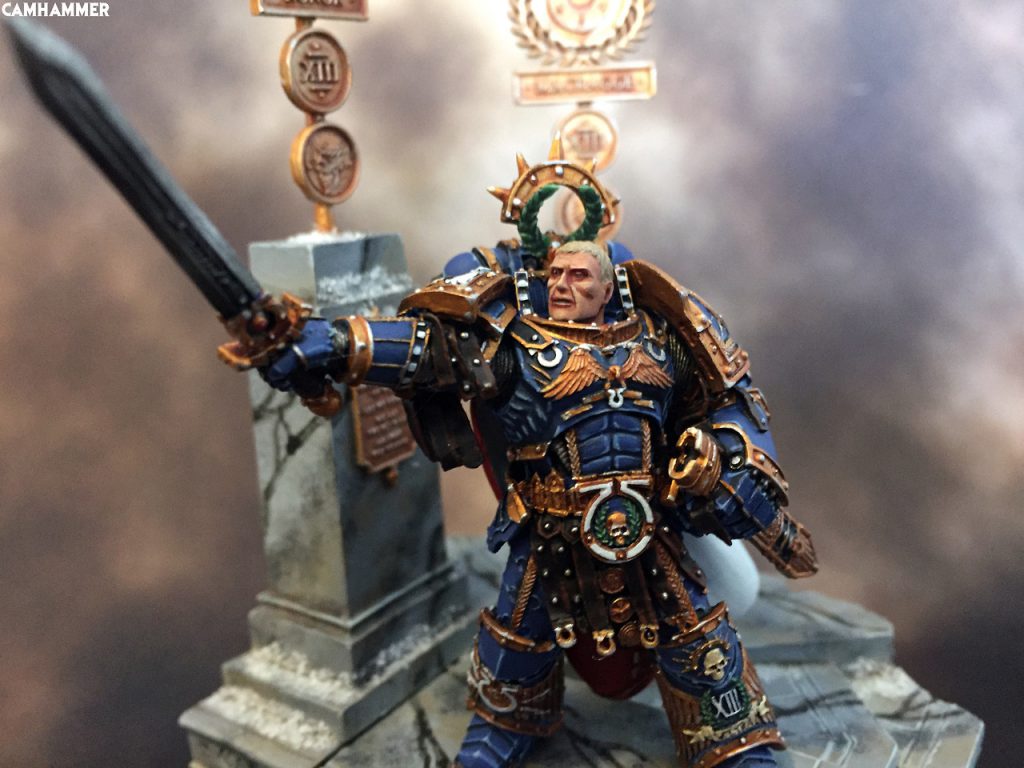The Warhammer 40,000 universe is a massive place, and the “Narrative Forge” hobby articles encourage thinking outside the box (literally) when putting models together and stretching yourself out in the hobby. They aim to make hobbyists and players comfortable growing beyond imitating the models they see in their Codexes and playing the rulebook missions, and serve as a source of inspiration for anyone wanting to forge new experiences in the hobby. This week, Charlie Brassley of the Beard Bunker blog and Tom Taylor Bigg are continuing our series on creating characters by talking about how to breathe life into your characters.
If you missed part 1, you can find it here.
Charlie: This article is all about adding character to your characters. Backstory is good too, and we’ll be touching briefly on that, but it’s for naught if one’s main hero/ine has all the personality of a pebble. I’ve made some pebbles in my time. So has everyone; so has Games Workshop.
This is a big topic and a detailed article, so here is what we’re covering at a glance:
- The intro. Tom and I talk about why both of us recommend writing your own characters, even though we have completely opposite approaches to doing so.
- Being mean to Papa Smurf. A comparison of two official characterisations, one of which sucks, and one of which doesn’t.
- Useful questions. A series of questions designed to help you create your own characters in the 40K mythos.
- Further advice & pitfalls.
- Tom’s approach. The bit where Tom explains his more laissez-faire approach.
Sample characters will be provided throughout to help get your imagination going.
Oh, and if you want your characters to have personality but aren’t excited about the prospect of writing some then don’t worry, we’ll get you sorted — my next post will be a definitely not even slightly tongue-in-cheek RANDOM PERSONALITY GENERATOR. You’re welcome.
Tom: My role in this conversation is to sit back in my dressing gown and listen to the marvelous madness of Charlie’s character creation process, and then talk about how my process is much lazier and much less structured, but how that creative process ends up defining the game for me.
A lot of the reason people find creating their own characters problematic is because we only tend to see them only at the end point. In GW’s case, with professional writers, designers, editors and sculptors combining, in our case following the many hours spent in our own company devising them. What we’d encourage you to do is not feel intimidated by that end point but to instead see the character creation process as a fun way of adding value to their hobby and that you can continue developing those characters for a long time, developing from small initial concepts (look up the first mentions of Leman Russ in the Rogue Trader book, for an example).
To spin off from the analogy, it’s fine to begin with a pebble, and as that pebble experiences the crashing of waves on the beach and is chipped and cracked you end up with one of those cool, weird pebbles that from the right angle looks like a dog’s head so you take it home and put it on your mantlepiece.
You might call my way of character creation ‘pebble polishing’.
Charlie: Tom you can’t polish a pebble. Wait, my bad, you absolutely can.
Tom: Charlie will link to his blog post about Martellus Lucullus, which is where his upfront creation has led to a very detailed and seemingly fully realised character before the army is much more than a handful of minis. My equivalent process for the Sons of Ananta took three years and gradual iterations of lore to form in response to the games I played with them.
The point (yes, Charlie, I told you I had one) is that these are ends of a spectrum and you can lift elements from them freely. Don’t be intimidated by a blank page. Games Workshop have done sterling work providing bones for you to flesh out.
Why go to all this effort?
Charlie: You might at this point be thinking “I’ve never written a characterisation for my toy soldiers before, why should I bother?”
Fair question. The short answer is that it’s another way to bring your tabletop battles to life. If giving your warlord a name is the narrative basecoat, giving them a personality is the shade and highlight.
Tom: A great analogy.
The way I see it, the characters you build and field are your avatars within the game. Most of my local friends have play styles that are reflected in their character models, and we can view the outcomes of the game through the prism of these characters.
In most of our hobby lives we spend comparatively much more time in building, reading, painting, modelling, daydreaming and chatting than we do actually fighting battles on the table top. I might play one larger game every few weeks.
And if it’s just about winning I don’t get the same fulfillment from the experience. But if I can place each battle as part of my army’s ongoing narrative and how my character reacts to the wins and losses, I end up with a far more satisfying overall experience.
Look at your favourite narratives, your favourite films, or sporting moments. Your favorite stories aren’t typically about a ruthlessly efficient machine utterly crushing its opponents. These moments where everything comes together are great, but they have to be put in context. It’s when the mission breaks down and the heroes improvise and dig deep on their way to a glorious victory or a cinematic and dramatic defeat. Last stands are the best.
SAMPLE CHARACTER: ADIS SHANGA
RECLUSIARCH OF THE SONS OF ANANTA CHAPTER
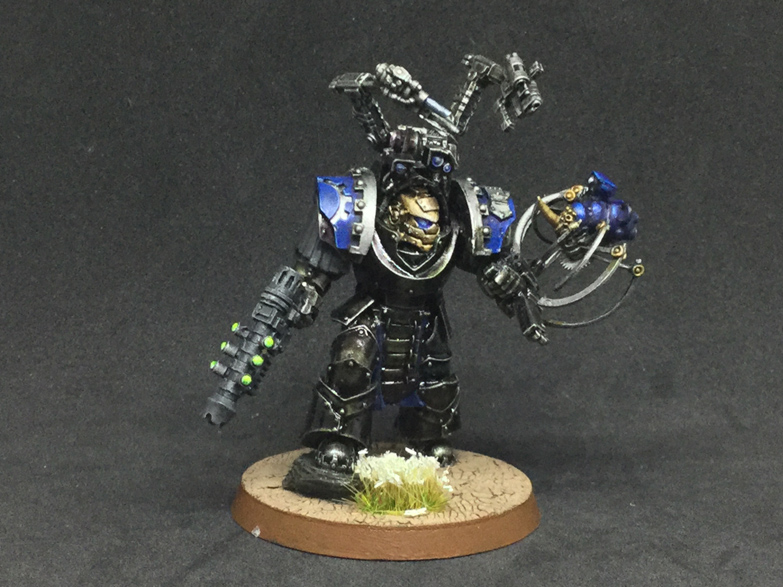
This character gave the heroic speech that served as the founding event of the chapter. As he fought in battles his character emerged as essentially a product of anger and resentment over the way his allies treated his army and this simple realisation shaped how the army was built and fought from there onward.
Comparing a pebble with an actual character
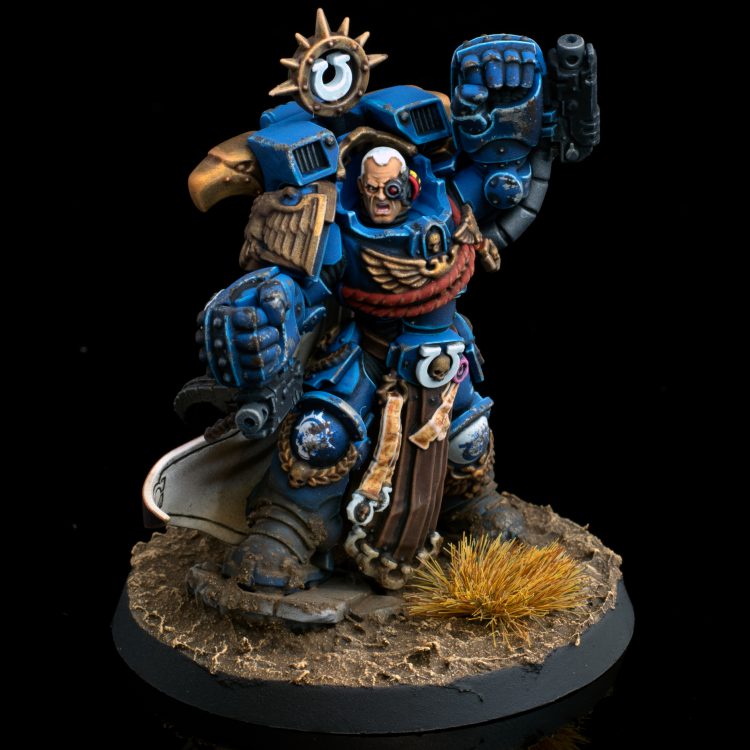
Charlie: First, the pebble: Marneus Calgar, the Ultramarines’ Chapter Master. Heresy, I know. Hear me out. He’s a great warrior (standard) and a great tactician (also standard) who values the lives of his men (I guess that’s kind of specific in the context of 40K?). He doesn’t really have any flaws, and his qualities are generic. I’ve read an entire novel about Marneus Calgar, and it didn’t get much more nuanced than that. There’s a semi-interesting bit in Guy Haley’s Dark Imperium where Calgar’s unsure of his purpose following Guilliman’s return, but that’s about it.
Tom: Winning isn’t a characteristic, and always being the best at everything isn’t interesting. A character obsessed by winning can be great, because that suggests a flaw, such as a great warrior not knowing when to cut their losses, or one who can’t resist the biggest challenge.
Charlie: To assuage any distraught Ultraboi fans out there (myself included), let’s contrast Calgar with Big Bobby G (sorry, Roboute Guilliman). The 13th Primarch has benefitted from the likes of Abnett and Haley taking the time to turn a fairly generic hero into the intelligent right-hand man who has to take charge because there’s no one else left. He knows he lacks the humour and charisma of his brothers, he knows he’s better suited to getting stuff organised and devising supergenius strategies while someone else does all the speeches and the rabble rousing, but there isn’t anyone else. Not any more. Worse, the Imperium he fought for has become the dogmatic nightmare he fought to destroy, he’s disillusioned after learning that his father only ever saw the astartes as a tool, and he’s worried that he’s been seeing the primaris marines the same way.
There’s a lot of painful self-knowledge there, a bunch of interesting conflicts, some pathos, and some flaws. When Guilliman gets to lash out in anger at a deserving subject (I’m looking at you, Word Bearers) you can understand and sympathise with him. Unless you think Erebus and Kor Phaeron had the right idea (continues shaking power fist at the Word Bearers).
Did you notice that I made no mention of Guilliman’s fighting chops? That’s because a space marine being good at their job isn’t interesting information unless they’re unexpectedly good (or bad) in some particular way.
With that in mind, let’s move on to creating your own characters.
The Main Course: Character Creation
Charlie: What follows is a series of questions about your character designed to help you think through your concept. They’re structured in a way I find intuitive, but can be answered in any order. These questions assume you have already chosen a faction and a unit (e.g. Farseer from Saim-Hann).
If you look at the model, what does it communicate?
Tom: GW sculptors and designers have done great work with giving their minis weight and emotion. Use that resource to tell you what your characters are.
Charlie: Agreed, it’s a great way to get the initial inspiration. And if you don’t like what the default mini is saying, you can change or emphasise certain traits by converting, kitbashing, or even just painting it a certain way. When I converted my primaris captain, I wanted something that looked more stately than the standard kit. I wanted to convey Thinky Gravitas™ more than Smashy Fightyness™. Here’s how that came out:
SAMPLE CHARACTER: CAPTAIN MARTELLUS LUCULLUS

This Ultramarine veteran volunteered to cross the Rubicon Primaris and help found a new XIII successor, the Cobalt Scions. His cautious and rational approach conceals an unhealthy amount of personal ambition; how dark a path that ambition leads him down remains to be seen. You can read more about Lucullus and the foundation of his chapter in this here post. FYI, it’s… a deep dive. Seriously deep. So deep it’d give Michael Douglas throat cancer.
SAMPLE CHARACTER: THE FALLEN TWINS
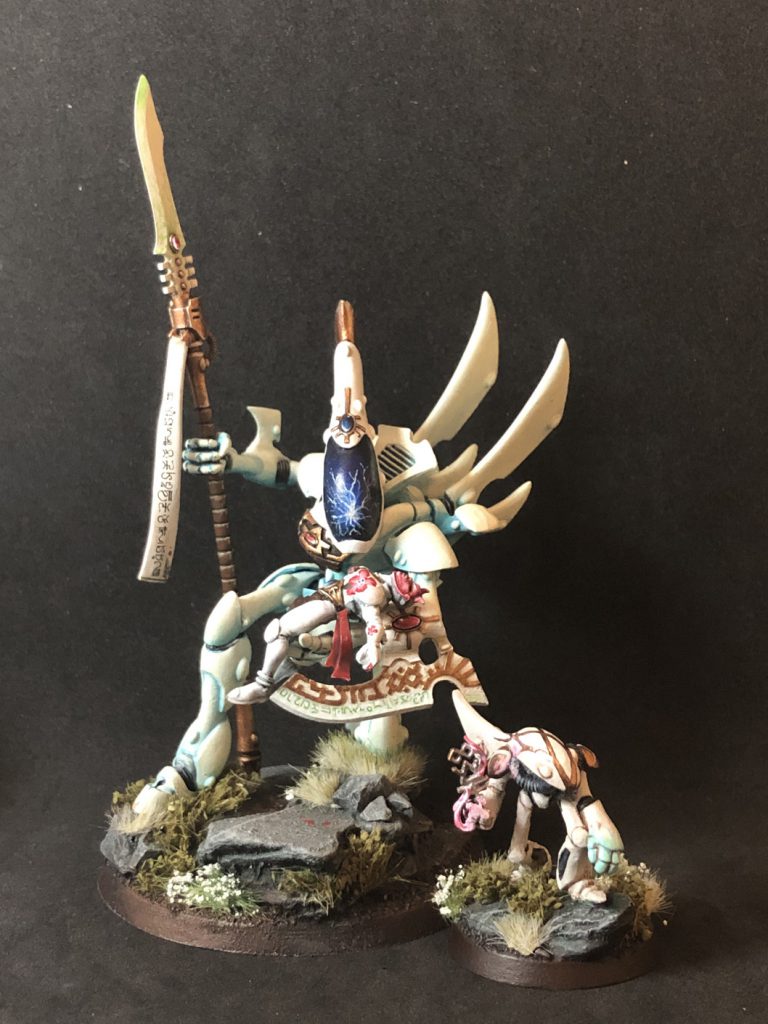
Ishyalla and Ishta were that rarest of aeldari children born after the shattering of the Aeldari – powerfully psychic twins. Precious and rare, as they grew, they achieved great things, but when the great rift opened it destroyed their craftworld in seconds. For many years the carcass of the gutted craftworld drifted, until Harlequins opened long closed webway gates and entered the craftworld. They sought the twin’s soulstones to power a great war machine.
Ishyalla had protected her sister’s spirit over the millennia but at the cost of her sanity. Ishta was still whole, but Ishyalla was utterly unable to power the war machine she was intended for. Some psychic remnant survived, with an instinct towards protecting her kinsmen, but with the consciousness of a young child.
Ishta was installed in a potent war engine, while the Spiritseers de-fanged an ancient ghost warrior for her crippled twin.
So, as the grim and driven Wraithseer marches to war, around it’s legs plays Ishallya, the happy child, playing and singing.
Are they a hero or a villain, and how much power do they have?
Charlie: There are heroes and villains in pretty much every 40K faction, at least from that faction’s perspective… with the possible exception of Tyranids (what do we want? Omnomnom. When do we want it? Omnomnom).
So what’s the difference between a hero and a villain? The former wants what they think is best for their followers, their faction, and possibly the galaxy as a whole. A villain is selfish, and generally holds everyone (often including their own followers) in contempt.
An Imperial villain might be one of those Imperial Guard commanders whose signature move is to drink fine amasec while thoughtlessly sending wave after wave of her troops to their deaths. Conversely, a hero might be a Chaos Lord whose humour and easy charm make a room full of embittered astartes buy into a sense of shared strife and the hope that they may yet regain lost glories.
Tom: This being 40k we are also in narrative territory where nobody is right. Even noble intentions can be cannibalised by necessity, so we can also tread the path of the anti-hero/anti-villain… It’s worth working out if someone is doing the right thing for the wrong reasons, or the wrong thing for the right reasons.
We are all pretty familiar with anti-heroes. A marine from a codex-compliant chapter who doesn’t fight by the rules, a driven Autarch who ploughs her own furrow, defying her superiors. At their best, a Drukhari character could be an anti-villain – in that they are preserving their way of life, their society, by committing a necessary evil but might be working to find other ways to preserve life for their kin, and their twisted nobility could be a great launching off point.
The other thing here is their place in society: How much actual power do they have to achieve their goal? A very capable T’au firewarrior leader might be hamstrung by being led by incompetents, while a Guard general put in office by their wealthy relatives might have far more power than ability.
This can help hone their role within their faction and how they feel about the actions they undertake.
SAMPLE CHARACTER: GRIMTOOF
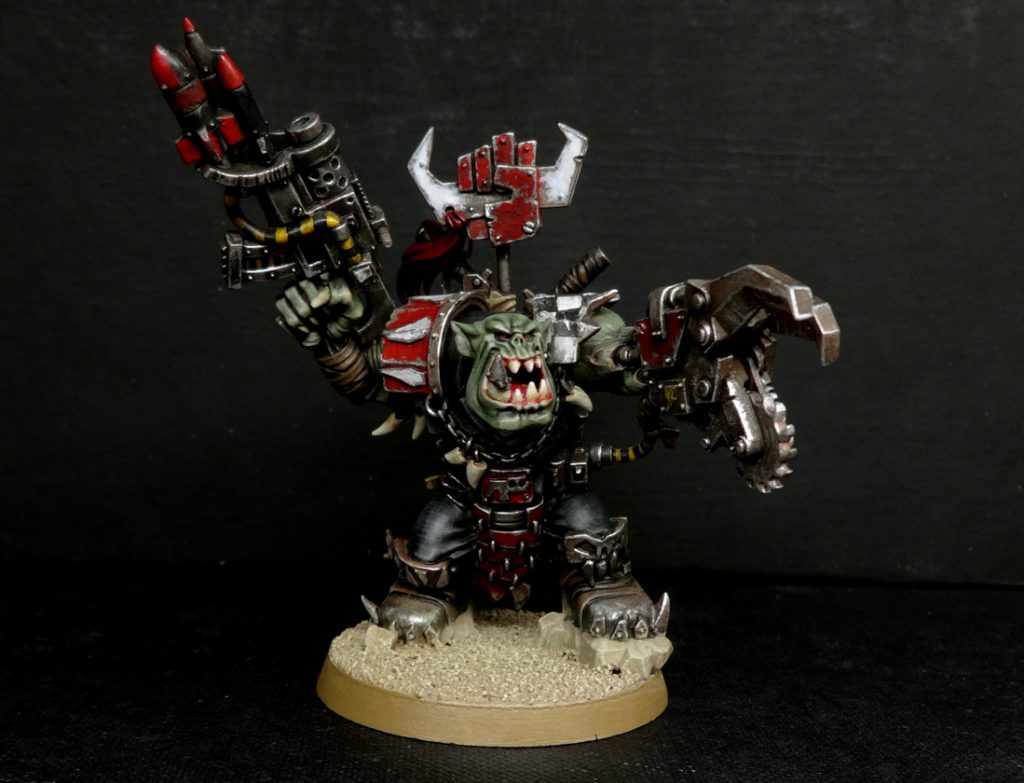
Being a speed freak, Grimtoof loves nothing better than riding his favourite wagon at face-flapping speeds through the desert. It’s the romance of journeying off in search of the unknown: unknown foes, unknown loot, unknown… unknowns. His second-favourite thing is tinkering with his ride. This is unfortunate, because he’s very much not a mek, and is absolutely dreadful at it. The tribe’s worst-kept secret is the number of times he’s had to call a professional in to fix another one of his attempts at a kustom job.
At one point he went a bit weird and depressed, and said he wanted to open up his own garage. The lads were worried. Naturally the garage got absolutely no business (or at least, no repeat business), and Grimtoof eventually conceded that an ork of his size really should go back to warbossing. A resigned backhand slap was all he needed to oust the wee boss who’d sprung up in his place, and everyone cheered, pleased to see the natural order restored. Back to the desert, back to the dust, back to roaring engines and belching exhausts.
What are their defining traits?
Weak characterisations often only have one identifiable attribute, whereas if you can’t sum up a character in one sentence, they’re probably too complex and won’t come across very clearly to other people. A good way to prevent this is to figure out what their defining qualities and flaws are. Here are some examples from 40K canon:
Gregor Eisenhorn: rational and tenacious but aloof and emotionally remote.
Garvel Loken: honourable but naive.
Cato Sicarius: charismatic but egotistical.
If you think through various pop culture settings (i.e. Star Wars/Trek, Marvel, Game of Thrones), all the most beloved characters have a couple of defining qualities and flaws, whereas all the blandest characters only have one note.
With that in mind, you can create pretty much any character by answering the following questions:
What are their defining qualities?
Pick a couple of traits that define the character’s best side. Examples: altruistic, assertive, brave, cheerful, confident, congenial, considerate, decisive, disciplined, earnest, empathetic, ethical, forgiving, generous, helpful, honest, honourable, humble, humorous, idealistic, inquisitive, meticulous, modest, nonchalant, optimistic, pragmatic, responsible, suave, trusting.
What are their defining flaws?
Pick a couple of traits that define the character’s worst side. Examples: anxious, arrogant, boastful, blunt, conformist, cynical, depressed, dishonest, envious, hard-hearted, insecure, impatient, indecisive, jealous, lazy, materialistic, naïve, narrow-minded, opinionated, overly ambitious, overly competitive, paranoid, pretentious, rash, rebellious, restless, selfish, self-righteous, short-tempered, stern, submissive, tactless, unreliable, vain, vengeful.
What do they want?
This could be a rank, revenge, a MacGuffin, recognition, survival, to safeguard their troops, to further political or tactical goals… you name it. The character’s Want will be maximally interesting if it’s not the same as their faction’s default objective, so a space marine who only wants to smite the Emperor’s foes isn’t a want worth mentioning. A space marine who’s desperate for personal fame, however, is a Want that could lead to some interesting conflict.
Do their troops follow them out of loyalty or obligation?
How are they perceived by their allies?
How are they perceived by their enemies?
What has been their greatest achievement to date? And their greatest failure?
Next, here’s how you could ask slightly different questions if you’re explicitly trying to create a villain:
What makes them intimidating?
What’s their most redeeming feature that makes someone sympathise with or respect them?
What is their greatest vulnerability/weakness?
What do they want?
To reiterate, I’m using the term ‘villain’ to refer to an unsympathetic and repellent character. Thanos was the big antagonist in Marvel’s story arc, but from his own perspective and that of his followers, he’s a hero willing to make painful sacrifices to do what he thinks is the right thing. Similarly, the motivations of the Operative in Joss Whedon’s Serenity are heroic, even if we don’t agree with him.
Let’s use Star Wars’ Emperor Palpatine as an example of answering the villainous questions, even though he is, charitably, pebble-adjacent: he’s intimidating because he’s got INFINITE POWERRRR both politically and zappily. His redeeming feature is the patience needed for all those political plays. His greatest vulnerability is having no faith in anyone’s ability to do the right thing after they’ve had a taste of the dark side. What he wants, seemingly, is to bring his flavour of order to the galaxy, but more personally, the satisfaction of goody two-shoes admitting that the dark side is indeed delicious.
SAMPLE CHARACTER: WATCH-SERGEANT ELIAS
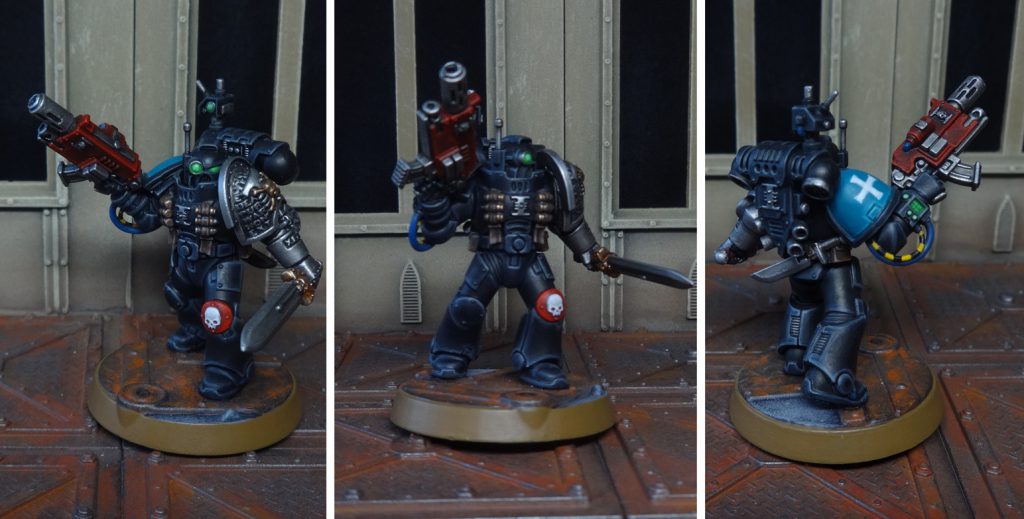
When Brother-Sergeant Elias joined the Deathwatch, he should probably have declared himself a blackshield. It would’ve stopped his brother marines asking questions. Instead, Elias foolishly answered the questions.
Yes, I’m from the Templars Errant. Yes, we lost our homeworld because the populace rebelled and the Black Legion got wind of it. Yes, the chapter’s gone on an indefinite crusade in penance, and I was banished from the chapter. Why? Because the chapter master disapproved of my decision not to act on a suicidal opportunity to rescue the chapter banner. What? Yes, when your chapter’s badly damaged I think ten marines are more important than a flag. That was… years ago, now. What have I done since? Spent time working for the Ordo Hereticus. Well, obviously, I can’t tell you. Being away from Chaplains for that long was strange. A mind without purpose will indeed wander in dark places, but with the Inquisitor’s help, I think I’ve made sense of it all. So now I’m here; ready to make myself more useful more frequently. Please don’t ask any more questions; I’ve been told my answers can confuse or upset properly indoctrinated marines.
Additional fine tuning
If you want to drill down further, here are some things to consider:
- Do they have a family or close-knit group of friends? Are they still a part of the character’s life?
- What secrets is the character keeping?
- What is their secret shame?
- What makes them happy? Excited? Angry? Embarrassed? Scared? Note: the question of fear is an important one, and it’s best to make your answer more specific than something like ‘a fear of failure.’ Answers might include phobias, insecurities, or something relating to a past trauma.
- What are their religious beliefs? This will probably be determined by their faction, but they might have secret or non-mainstream beliefs they keep to themselves. Equally they might be more or less pious relative to their peers.
Characters in relation to each other
If you’re coming up with a bunch of characters who are all going to be present in the same force, it can be entertaining to think about how they’ll interact with each other. By way of example, let’s go through some of the characters in my Guard army, a platoon from the 107th Ankran Mechanised.
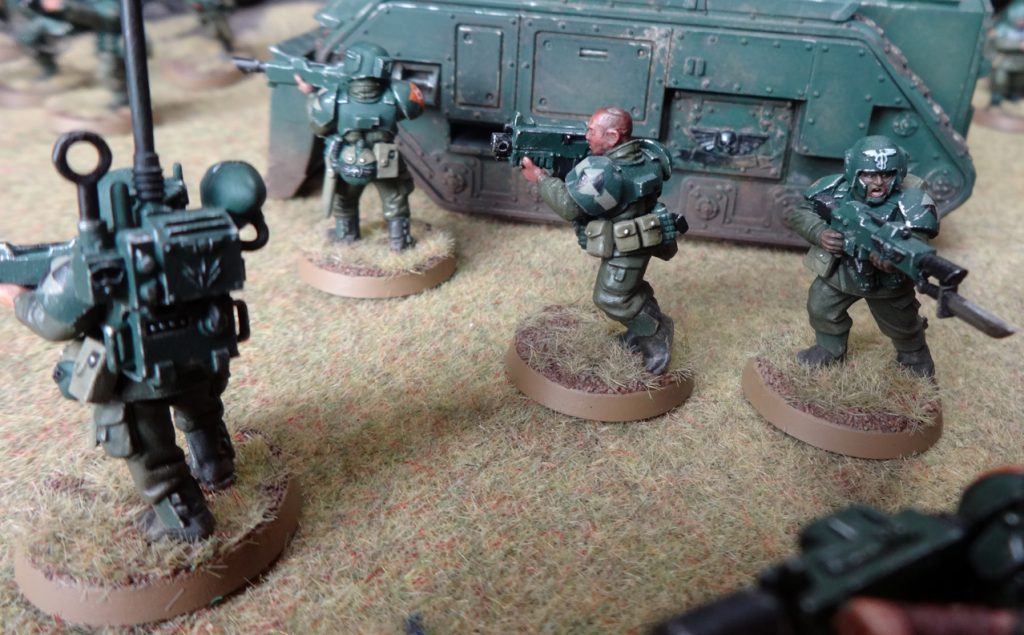
Warlord: Major Adi “Bolt” Kahurangi
Informally referred to by others in his company as “Bolt,” much to the disapproval of the commissar, Adi Kahurangi was a hot-headed lieutenant when the 107th was deployed during the ork invasion of Samalut IX. His propensity to run towards danger at the first opportunity earned him his nickname, and the moniker was cemented when the company major gave Kahurangi his boltgun as thanks for saving his life in the Kidaaran Deadlands. This perceived favour irritated the other officers of the 3rd company, who felt that Kahurangi was a liability who had yet to understand that an officer’s duty is not to fight but to orchestrate.
Naturally the boltgun only increased Kahurangi’s propensity for rashness, and it was only tempered at the Battle of Besid Gorge, when an over-enthused attack on an ork warband went horribly wrong. 2nd platoon suffered 50% casualties, Kahurangi was injured, and squad 3 was wiped out entirely. The orks were destroyed, but the cost of victory changed Kahurangi, who thereafter favoured the more conventional Ankran strategy of the redeployable firebase.
Losses throughout the Samalut campaign resulted in Kahurangi rising through 3rd company’s ranks by virtue of being the most senior person left alive, and Kahurangi – now the company commander – doesn’t feel he’s earned his position, but takes his job very seriously. That said, a gleam almost always comes to his eye in a crisis. His willingness to listen to his officers’ suggestions and his enthusiasm for safeguarding the Imperial populace make him popular with his men, even if his reckless past and relative inexperience make others in the 6th battalion wary of him.
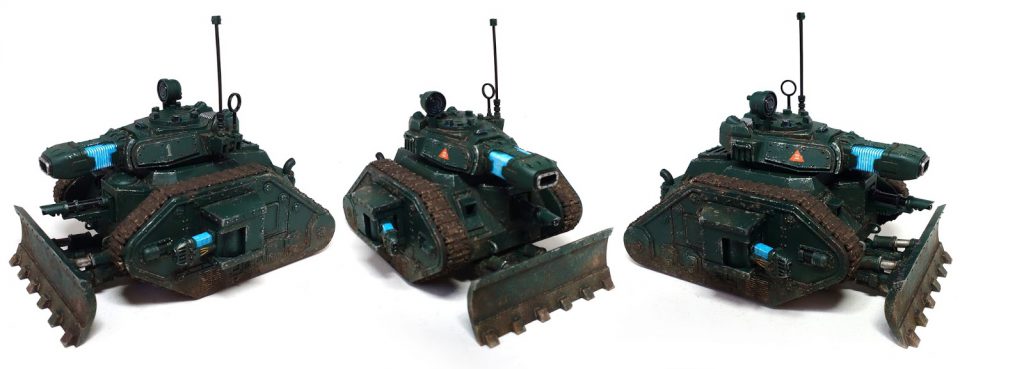
Lt. Dewi Kusuma (commander of the tank squadron attached to 2nd platoon)
As an avid student of the Tactica Imperialis, Kusuma regularly finds herself at odds with Major Kahurangi. He welcomes her objections, and often alters his plans in response to her input.
Kusuma is a demanding officer obsessed with tidiness and following protocol. Most people assume it’s just in her nature, but those who’ve been in the washrooms with her note the lash scars on her back that suggest she didn’t always have such a deep respect for the rules. Those who know her even better – namely, the other officers in the company – understand that she is terrified of failing to achieve the standard required of her, even though her performance is exemplary.
She is also fiercely competitive when playing barrelball, a rudimentary game played by many Ankran soldiers. The tendency for Ankran officers to involve themselves in this game is frowned upon by officers of noble birth from other regiments.
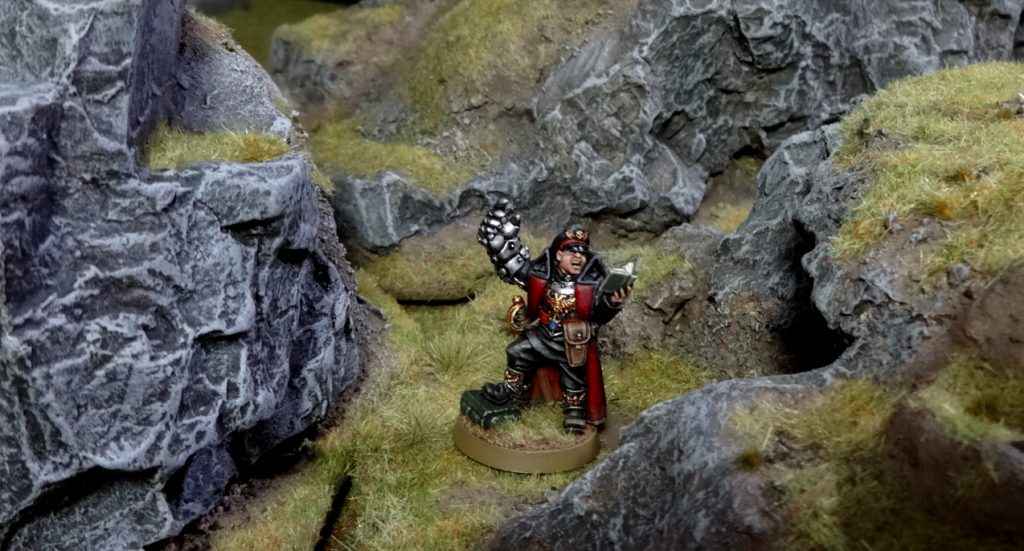
Commissar Isaiah Lachlan
Lachlan, like many other political officers, was assigned to the 107th to try and curb the inappropriate bonhomie and enthusiasm of Ankran soldiers. A keen orator, Lachlan needs little excuse to recite passages from the Imperial Infantryman’s Uplifting Primer and the Tactica Imperialis. The experienced soldiers of the 3rd company mostly ignore him and get on with their duty, smirking behind his back but careful to make sure they aren’t caught in the act. Lachlan remains convinced he’s making a difference, and takes great pleasure in telling other commissars of his success.
Note how Lachlan’s classic Imperial values are clearly going to clash with the Major’s general attitude, and how the Major is pretty much the opposite personality to his 2nd in command (Kusuma, the tank commander). Imagining said friction amuses me as I flail about on the tabletop attempting to get my heavily-armoured ducks in a row.
Dessert: Pitfall Souffle & Advisory Brandy
Should I make up special rules for my character?
I would suggest that no character or unit should have a special rule unless it’s difficult for them to act thematically on the tabletop without one. If my commander is particularly keen on charging headlong towards the foe, the default rules allow me to make that thematic decision.
Ultimately, having a special rule won’t inherently make a character compelling. Indeed, I almost never give any of my characters special rules; I just represent them on the tabletop by making the tactical decisions I think they’d make. This has the added advantage of not needing anyone’s permission to use your favourite hero.
That said, many people really enjoy adding such rules to their character, and “necessary” isn’t always the same as “fun.” If you and your opponent agree to their use, the character creation rules in Chapter Approved 2018 have a lot of flexibility, and if you remember that having the Legendary Dagger of Stab isn’t a substitute for actual personality, this can be a useful tool in your arsenal.
We already talked about using these rules and making custom rules for your custom characters in last week’s Narrative Forge, which you can check out here.
Public advisory: it’s your own private narrative, or, don’t be that gamer.
Obviously this is an area of the hobby I get rapturously geeky about, and with great enthusiasm comes great potential for subjecting my mates to an unsolicited lecture about my character, their 500 page backstory, their family tree, and their favourite potted plant.
The unfortunate reality is that just because I am excited about my character doesn’t mean other people are automatically interested. If they show interest, I give them the quick version. If they ask follow-up questions, I try to be concise. That way the person I’m talking to is in control of the conversation, and they’re able to get the amount of information they want. I’ve avoided being a bore, and they’ve satisfied their curiosity.
So if I have all this narrative in my head, why am I keeping quiet about it? Because actually, a big part of narrative gaming is bringing the battle to life in your mind, and that’s not a process that inherently requires your opponent to participate. If they’re like-minded then that’s a definite bonus, and you can totally natter about it during the game, but not everyone’s into that and I don’t need them to be. My favourite games of 40k have been those times that my opponent has also taken a mythos-compatible list, put time and effort into their minis, and plays to win within the voluntary constraints of making cinematic sense.
(As an aside, if I’m introducing someone new to the game then I will usually play a small game and narrate things in more detail to bring it to life, since they don’t know the setting and have no idea what any of this stuff is).
The dangers of making Captain Badass
Bitter experience has taught me that it’s a risky move creating a character whose main attribute is being totally amazing at fighting, since you’re going to be rolling dice, and those dice are going to betray you at some point. If your whole concept of the character is predicated upon them succeeding, then your narrative might not survive contact with the tabletop. Embrace their failures as much as their successes and you’ll get a better narrative experience with them.
How do you solve a problem like Alpharius?
Tom: There are a few factions that thrive on being tricksy and enigmatic. Tzeentch, various Inquisitors, Alpha Legion and Harlequins spring to mind. It’s very easy to have these factions respond to every reverse with ‘just as planned’ but this can be exasperating for your opponent as well as a way to avoid consequences for your own faction’s reverses. If your characters are from these factions or have hidden agendas it’s fine not to tell anyone what they are. But you should really know yourself. It’s a more satisfying character to play and develop.
Humour: Be compatible with your opponent
Charlie: The 40k mythos is a joyously ridiculous setting, and taking it ultra-seriously will rarely increase anyone’s net joy. At the same time, be mythos-compatible with it. If I call my Ork warboss Ronuld Murkdonnuld and give him a big red nose because red ones blow faster, I’ll probably damage my opponent’s immersion for the sake of some extremely fleeting giggles. Or no giggles at all, if they have a more sophisticated sense of humour than me (hint: I’m extremely not over dick jokes).
Keeping a record
If you have a memory even slightly like mine, you’ll want to record your work. You may even want to share it with other people. If you’re planning to share it, then it makes sense to present it in an enjoyable format. Blogs are particularly good for this, since you’re not forcing anyone to sit down and listen; those that are interested can come and go as they please.
There’s a number of ways of presenting a character’s background. My fellow Beard Bunker author Jeff wrote an enjoyable trio of posts about his Inquisitor’s warband, written from the perspective of that Inquisitor. You can check those out here: Part 1, Part 2, Part 3.
The easier method: Tom Taylor Bigg
Tom: I’ve been a bit quiet for a chunk of this latter portion because although Charlie has been giving excellent questions, it’s not my method. Or at least, it’s something I retcon into my characters as they emerge rather than front load as heavily as Charlie does.
I like to have a kernel of these questions answered, and then allow the games to shape how these characters behave. Obviously playing in a campaign, or in other narrative environments is the most obvious way to do this, but you don’t ever have to turn that narrative off.
One of the constant discussions we have in 40k is what defines a ‘narrative’ player, and how to create a narrative you need cooperative and keen players. This is true on a larger scale, but it’s also possible to have a game against someone who has zero interest in a larger narrative scheme and still have a narrative experience. If you treat each game as part of your character’s history, characters can still emerge. In fact, my favourite of all characters is the one that emerges from the table without you having put any thought into them beforehand.
Charlie: It’s a good approach; I have a number of friends who do the same.
I also use this approach after the initial act of creation. You don’t want to set your characterisation in stone; create them, but then let them be affected by the events that occur on the tabletop, and you’ll get a pleasing mixture of well thought-out characters and an evolving record of their exploits – hopefully something that will work perfectly with the Crusade rules from the upcoming edition of 40K.
Robert “TheChirurgeon” Jones: I did this with my campaign warmaster, the Sorcerer Kaervek, and a few of the players in my campaign did the same, treating the campaign like a sequel story and updating their warlords’ backstories to include the events that unfolded in that campaign. I’d highly recommend it, and I’d especially recommend adding to the model over time if you can — adding a trophy to their racks or extra details onto their base to celebrate a major victory or moment can really help bring that to life.
Next time: the Random Personality Generator
Hopefully today’s post will help you flesh out your characters, or even inspire you to have your first crack at it. Use as much or as little as you like; as Tom pointed out, no one process is gospel.
And if you’re still stuck, don’t worry. I’ll be back in a few weeks with the definitely extremely serious personality generator. In the meantime, if you have any questions or feedback, or want to share a character of your own making, drop us a note in the comments below or email us at contact@goonhammer.com.

